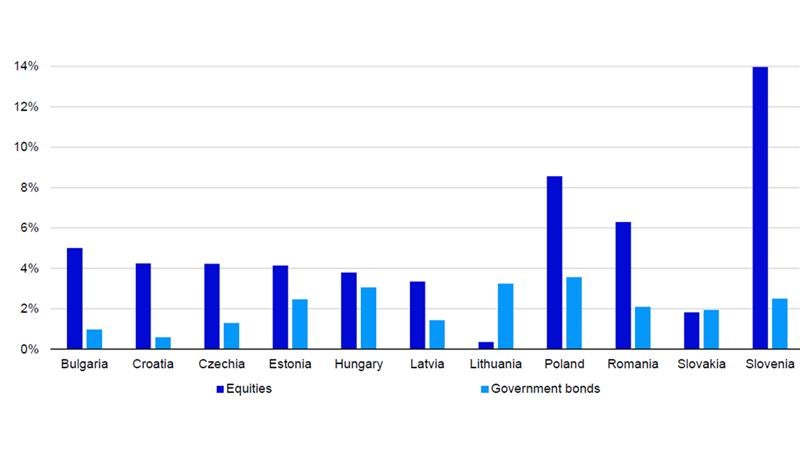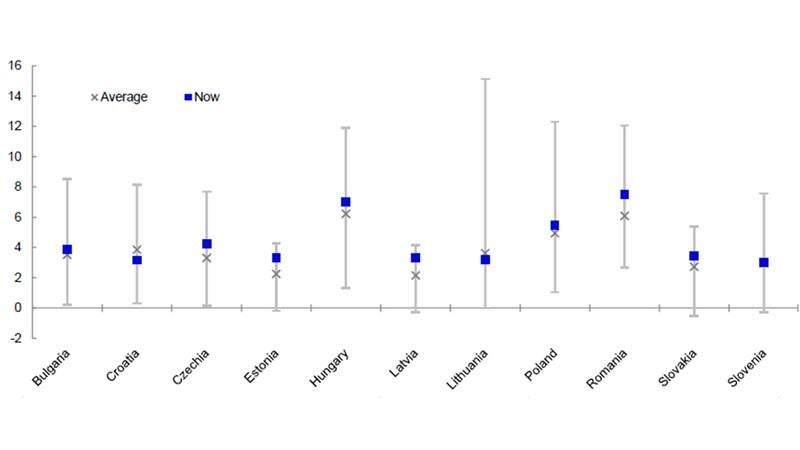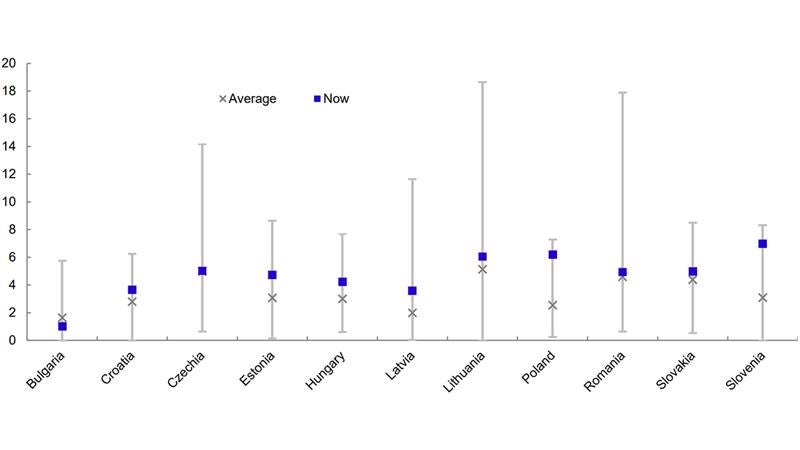Applied philosophy: Strategist from East of the Elbe - Q3 2025

The total returns on assets in Central and Eastern EU member countries (CEE11) have been more subdued within both equities and government bonds in the last three months. Inflation has remained elevated in most economies alongside interest rate expectations as global economic indicators seemed mixed with continuing geopolitical risks and policy uncertainty in the US. We expect growth to reaccelerate in the next 12 months both within and outside the region, although we expect inflation to stay above central bank targets in the short term. In my view, this outlook should support both government bonds and equities in our CEE11 universe.
As we are cooking in the early heatwaves of June, thoughts turn to the second half of the year. Risk assets have recovered from the convulsions driven by tariff policy uncertainty in early Q2 2025 and have weathered more recent geopolitical risk in the Middle East. Will the sun continue to shine on global equities?
Equity returns since the end of March in the CEE11 countries within our universe have been lower than in Q1 2025 (though Slovenia had double-digit total returns), while government bond returns remained subdued. Within equities, we highlighted Slovenia and Poland as our most preferred markets in our last edition, while we thought Bulgaria and Hungary were likely to underperform (see here for the full detail). As shown in Figure 1, Slovenia was the best performer and Poland the second best. At the same time, while returns for Bulgaria were in the top half, Hungary had the fourth weakest returns.
Government bond returns were positive, but in the low single digits for all CEE11 countries as inflation stayed high. We chose Romania and Poland as our most preferred in our last edition. Although Poland was the best performer, Romania was only the sixth best despite the election of a centrist president and plans of fiscal consolidation. On the other hand, we highlighted Croatia and Lithuania as our least preferred. While Croatia had the weakest returns, Lithuania was the second best performer between 31 March and 30 June 2025.
Government bond yields declined slightly in most countries due to signs that inflation rates may be stabilising and as the US “trade war” rhetoric moderated. Apart from Czechia, Latvia, Lithuania and Slovenia, the International Monetary Fund (IMF) expects fiscal deficits to decline, although in some countries, such as Romania and Poland they may remain elevated partly due to higher spending on interest payments (plans for higher defence spending may add upward pressure to deficits and yields). At the same time, the rise in yields in Croatia and Czechia was far from dramatic at two and seven basis points respectively.

Notes: Past performance is no guarantee of future results. Data as of 30 June 2025. We use Datastream Total Market indices for equity returns. Government bond returns for Czechia, Hungary and Poland are based on Datastream 10-year benchmark government bond indices. We create a monthly index of government bond returns for all other countries by calculating the net present value of coupon payments and capital repayment based on redemption yields.
Source: LSEG Datastream and Invesco Global Market Strategy Office
The political landscape is likely to be more settled in the next 12 months after the turbulence in Poland and Romania around their respective presidential elections. The next potential flash point is the Czech parliamentary election, which will be held in the autumn of 2025. After that, the parliamentary elections in Hungary and Slovenia in April 2026 are probably too far ahead to appear on the markets’ radar.
We expect most Developed Market (DM) central banks to continue easing monetary policy, but we think the process will be gradual as rate setters remain mindful of upside risks to inflation, especially as the impact of rising tariffs becomes clearer, especially in the US. I think CEE11 countries are highly exposed to disruptions in global trade, especially those outside the euro area, where currency movements can become volatile if investor sentiment sours. As Figure 2 shows, the Hungarian and Romanian central banks again left their rates unchanged in the most recent three months, while the Czech National Bank (CNB) cut its target rate by 25bps and the European Central Bank (ECB) by 50bps. The National Bank of Poland (NBP) cut rates by 50bps in Q2, followed by another 25bps on 2 July 2025 to 5%.
In our view, the global economy could reaccelerate in the next 12 months after going through a phase of weaker growth, especially in the US, thus some central banks may be nearing the end of their easing cycle (though not the Fed). In CEE11, GDP growth in Q1 2025 decelerated in most countries, although remained positive (except for Hungary, Latvia and Slovenia). I expect the laggards, especially those that are exposed to the industrial supply chains of the German economy (for example, Hungary and Slovakia) to catch up to the better performers, such as Bulgaria, Croatia, Lithuania and Poland, as higher infrastructure and defence spending boost economic growth in the Euro Area.
That probably implies no significant decline in inflation in the region, and therefore interest rates may remain near current levels, in my view. I think a lot will also depend on how long policy uncertainty remains and how much that impacts economic growth especially in H2 2025. It would not surprise me if central banks adopted a wait-and-see approach and would lean towards holding rates at current levels, while monitoring economic indicators.
In CEE11 countries, I think growth will stay higher than in DM assuming decent real wage growth and no need for monetary tightening in response to higher inflation or currency weakness. In my view, fiscal policy is likely to be expansionary or neutral in most countries (apart from Romania, for example), although spending may be constrained somewhat by higher debt servicing costs.
I think the global macroeconomic backdrop will also be supportive of regional assets in general. In our latest The Big Picture, we reiterated the view that the prospects for growth may improve in the next 12 months, although there is some uncertainty around the future path of inflation, especially in the US with the potential impact of higher tariffs. Accordingly, we maintained our cautious overweighting of risk assets (though we remain Underweight US equities), and we maintained our preference for Emerging Markets.

Notes: Past performance is no guarantee of future results. Data as of 30 June 2025. Using daily data from 1 January 2005.
Source: LSEG Datastream and Invesco Global Market Strategy Office

Notes: Past performance is no guarantee of future returns. Data as of 30 June 2025. Historical ranges and averages include daily data from 14 April 2006 for Bulgaria, 30 January 2008 for Croatia, 1 May 2000 for Czechia, 1 February 1999 for Hungary, 15 April 2003 for Lithuania, 1 January 2001 for Poland, 16 August 2007 for Romania, 7 January 2004 for Slovakia, 3 April 2007 for Slovenia and 24 November 2020 for Estonia and Latvia. We use Refinitiv Government Benchmark 10-year bond indices for Bulgaria, Croatia, Lithuania, Romania, Slovakia and Slovenia. We use Datastream benchmark 10-year government bond indices for Czechia, Hungary and Poland. We use OECD 10-year government bond yields for Estonia and Latvia as of 30 May 2025.
Source: LSEG Datastream, Organisation for Economic Co-operation and Development, Invesco Global Market Strategy Office
What does this imply for markets? The main question, in my view, is how far and how quickly growth reaccelerates after getting through a potential soft patch in the short term. A risk-off environment in the near term could mean that until we get more clarity on the outlook for growth (especially for the Euro Area) CEE11 assets may underperform EM and Global benchmarks. However, on a 12-month view, I remain positive on the prospects of both equities and government bonds within CEE11, especially if USD weakness persists (we consider them risk assets within a global asset allocation context).
The Czech koruna and the Hungarian forint strengthened, while the Polish zloty and the Romanian leu weakened against the euro in the last three months, which may have been driven by the difference in inflation expectations. Rate futures and Reuters consensus forecasts indicate rate cuts of at least 50bps for Poland, around 25bps for Czechia, Romania and Hungary compared to about 25bps for the ECB and just over 50bps for the Fed until the end of 2025 (as of 3 July 2025). Thus, apart from the PLN which could weaken in the next 12 months, I expect limited movements in exchange rates versus both the euro and the US dollar, unless there is a sudden deterioration of economic momentum (either within the region or globally).
In absolute terms, the 10-year yields of Romania and Hungary at 7.5% and 7% respectively are the highest, which is not surprising given that they also have the highest central bank rates within the region (as of 30 June 2025 – see Figure 3). In general, I would expect CEE11 yields to be lower than the 6.6% yield on the broader EM universe (Figure 6 – based on the Bloomberg Aggregate Sovereign Bond Index in USD as of 30 June 2025) due to their structurally lower inflation and interest rate expectations.
Romanian yields have the potential to decline if political turbulence subsides further and planned fiscal consolidation is carried out. However, in Hungary’s case, plans for fiscal loosening may not leave much room for strong returns, especially if interest rates remain higher than in the rest of the region. On the other hand, I think Czechia has more potential for outperformance, especially if inflation moderates. Polish government bonds may have the third highest yield in the region at 5.5% (see Figure 3), but there is a risk that the newly elected president could block further reforms. At the same time, Croatian and Lithuanian bonds seem to have the least attractive valuations with yields and spreads versus Bunds below historical averages.

Notes: Past performance is no guarantee of future returns. Data as of 30 June 2025. Based on daily data using Datastream Total Market indices. Historical ranges and averages include daily data from 2 October 2000 for Bulgaria, 3 October 2005 for Croatia, 27 January 1994 for Czechia, 5 June 1997 for Estonia, 21 June 1991 for Hungary, 3 November 1997 for Latvia, 1 April 1998 for Lithuania, 1 March 1994 for Poland, 29 December 1997 for Romania, 1 March 2006 for Slovakia and 31 December 1998 for Slovenia.
Source: LSEG Datastream and Invesco Global Market Strategy Office
Despite the somewhat uncertain economic outlook in the short term, I expect healthy equity returns in the region based on our assumption of global economic acceleration in the next 12 months. While there may be a few bumps in the road in the near term, valuations look favourable in most markets within the CEE11. Apart from Bulgaria, they also offer higher yields in absolute terms than the 3.3% of the broader EM universe (using Datastream Total Market indices as of 30 June 2025). In my view, Slovenia and Poland continue to be in the sweet spot of having a dividend yield well-above historical norms and relative to their peers in the region with Estonia and Hungary also looking attractive (see Figure 4) despite strong double-digit returns year-to-date. At the same time, I still view Czechia as an attractive hedge against potential market volatility in the near term with its dominance by the country’s largest utility company.
On the other hand, I cannot overlook the low yields on offer on Bulgarian equities, which are also the only ones below their historical averages. At the same time, although absolute yields are higher in Romania and Lithuania, their yield premiums compared to historical norms are now the second and third lowest within the region respectively, thus I view these markets as having the least potential for outperformance.
Figure 5 – Our most favoured and least favoured markets in Central and Eastern Europe
| Government bonds | Equities | |
|---|---|---|
| Most favoured | Romania, Czechia | Slovenia, Poland |
| Least favoured | Croatia, Lithuania | Bulgaria, Romania |
Source: Invesco Global Market Strategy Office
Investment risks
The value of investments and any income will fluctuate (this may partly be the result of exchange rate fluctuations) and investors may not get back the full amount invested.




